Based on the true story of the discovery of the Anglo-Saxon burial ground at Sutton Hoo, The Dig is a delightful showcase for the talents of two of our greatest actors, with Carey Mulligan as Edith Pretty teaming up with Ralph Fiennes as autodidact excavator Basil Brown to secure one of archeology’s greatest triumphs.


LARRY HORRICKS/NETFLIX © 2021
Based on the book by John Preston, the film brings in many themes from class and gender prejudice to our relationship with the past and even the very nature of time. Right alongside these is the power of place, as expressed in the unique landscape of river, marsh, coast and apparently endless sky of Suffolk. Surprisingly, while much of the film could only have been shot in the county, some of its key locations are in fact elsewhere in the UK.
SUFFOLK
Along with its much-filmed neighbour Norfolk, this beautiful part of the country has been raising its screen profile in recent years: Bury St Edmunds made a significant contribution to The Personal History of David Copperfield, Richard Curtis’s Yesterday featured Lowestoft and the coast, and the BBC’s wonderful Detectorists used Framlingham and surrounding countryside to depict its pastoral idyll, despite being set in Essex.


LARRY HORRICKS/NETFLIX © 2021
For director Simon Stone, the region surrounding Sutton Hoo was an essential part of the story. ‘You go to Suffolk once and visit the estuary lands and you see such a unique landscape, like a world that you just don’t recognise as quintessentially English,’ he said. ‘As you see, it’s constantly through the film. We keep cutting back to shots that were shot in the environment where it took place.’ Fiennes, a native of Ipswich, took the location to heart, working with a dialogue coach and remaining in character method-style throughout the shoot.
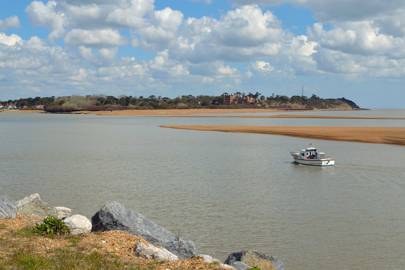

Bawdsey Ferry
Getty Images
In The Dig, we see the county mostly via Brown’s cycle journeys to and from work. The opening scene, showing him crossing the Deben estuary with his ever-present boneshaker, was shot at Bawdsey Ferry, between Felixstowe and Bawdsey. Later in the film, he passes by Shingle Street, the hamlet near Hollesley just to the north, while establishing shots were also taken in the villages of Butley and Iken, as well as Aldeburgh and Thorpeness beaches.
Particularly lovely is the scene where we see Brown on the banks of a river, smoking a pipe after he has made his first significant find. This is Snape Marshes and the River Alde, and the boat that appears magically before him is the Cygnet, a restored 19th-century sailing barge.


LARRY HORRICKS/NETFLIX © 2021
Also significant is Boyton Marshes, an RSPB sanctuary that’s also on the Alde but some way south. This is where we find the ruined brick house that becomes a focus for the relationship between archeologist Peggy Piggott (Lily James) and Pretty’s cousin Rory Lomax (Johnny Flynn).
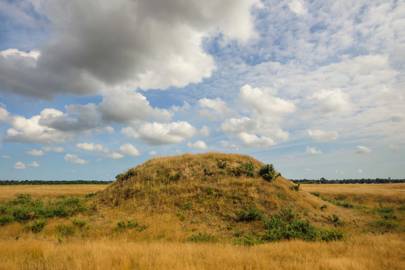

Sutton Hoo, the site of two medieval cemeteries in Suffolk
Getty Images
SURREY
For the dig itself, we’re not in Suffolk but in Surrey, close to Godalming between the villages of Puttenham and Shackleford (and to Norney Grange, below). When it came to recreating the scene, director Stone was in no doubt: ‘We had to do it for real,’ he told USA Today. ‘You need to present what it’s like to be there, the shock of sudden discoveries.’
This meant taking over areas of farmland and building the six burial mounds we see at the start of the film and planting them with wild grasses. Two of these were then used for the early stages of the dig, and a third for the discovery of the ship, which was recreated in fibreglass. However, the process was in fact filmed in reverse, with the open site created first and then filled in for authenticity. Throughout shooting, autumn weather played havoc with a schedule that called for very specific conditions: ‘It was raining when it shouldn’t rain, and then not raining when we wanted it to rain,’ says Stone. ‘We had to bring in huge rain machines.’
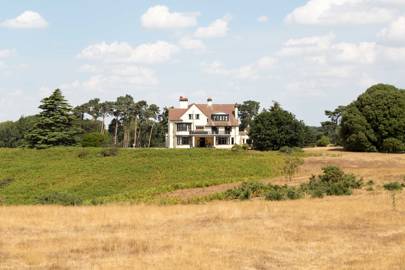

Tranmer House in Suffolk
Getty Images
THE HOUSE: NORNEY GRANGE
Pretty’s Suffolk home, Tranmer House, sits on the Sutton Hoo estate and is now a museum. Built in 1910 in Tudor Revival style, it is historically significant but aesthetically no match for the house employed as its stand-in for The Dig. This is Norney Grange, close to Shackleford in Surrey, a Grade II-listed building from the turn of the 20th century, designed by Charles Voysey, a leading light of the Arts and Crafts movement.
As well as filming the façade and garden, the crew also shot inside Norney Grange, where the wood panels, marble fireplace and half-domed ceiling have remained intact from Voysey’s time and add a further level of period charm to the film.
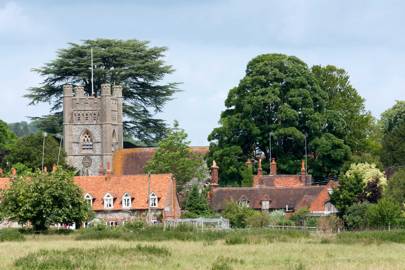

The village of Hambleden in Buckinghamshire
Shutterstock
SHACKLEFORD, SURREY AND HAMBLEDEN, BUCKINGHAMSHIRE
While Shackleford itself was also used, notably in the shape of the Diss Post Office filmed at the village shop, for the scenes set around the inquest in Sutton we are in Buckinghamshire, in the tiny hamlet of Hambleden. Perfectly preserved and picturesque, this is a location with some serious screen history, from Chitty Chitty Bang Bang in the 1960s to Good Omens in 2019, via Sleepy Hollow, mini-series Band of Brothers and numerous episodes of Midsomer Murders and Poirot. As well as the main street, we also see the village pub, where the archeological team celebrate their finds.
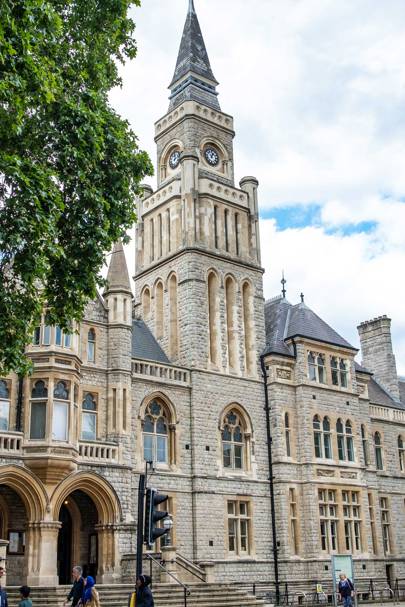

Ealing Town Hall, London
Shutterstock
EALING AND OXFORDSHIRE
Outside the main locations, Brown’s visit to Ipswich Museum was shot at Ealing Town Hall in West London, its 19th-century Gothic Revival grandeur very different from the red brick of the real thing. Pretty’s trip to London, meanwhile, takes in the Chinnor and Princes Risborough Railway Station in Oxfordshire, a preserved heritage steam railway. While she’s in the capital, we see the statue of Gladstone on the Strand being protected from air raids with the spire of St Clement Danes behind, an image of The Dig‘s theme of preservation of the past.
‘The Dig’ is streaming on Netflix
Like this? Now read:
What to do on the Suffolk Coast
The 10 best National Trust places in the UK to explore
The best film and TV dramas filmed in Britain






